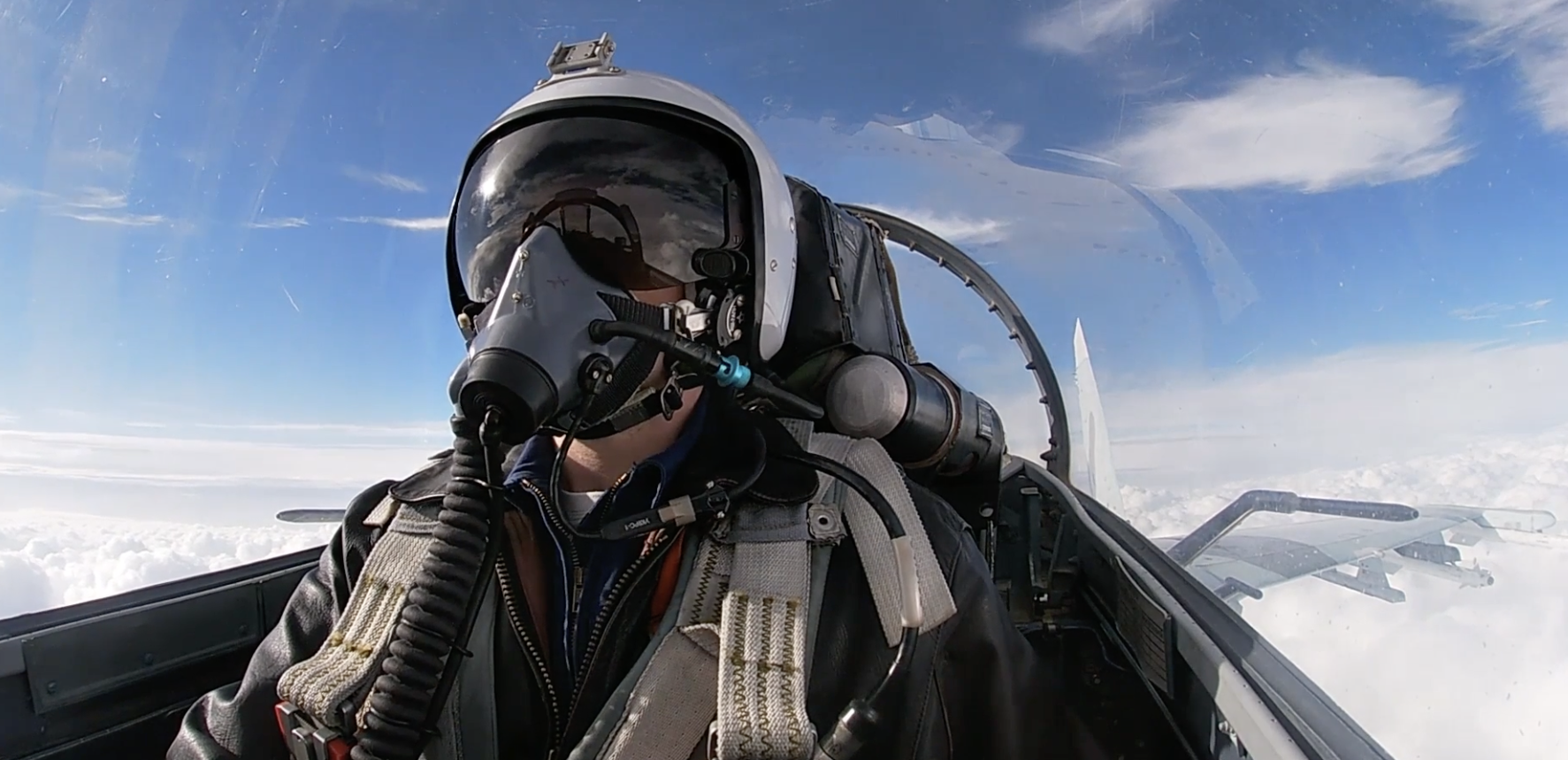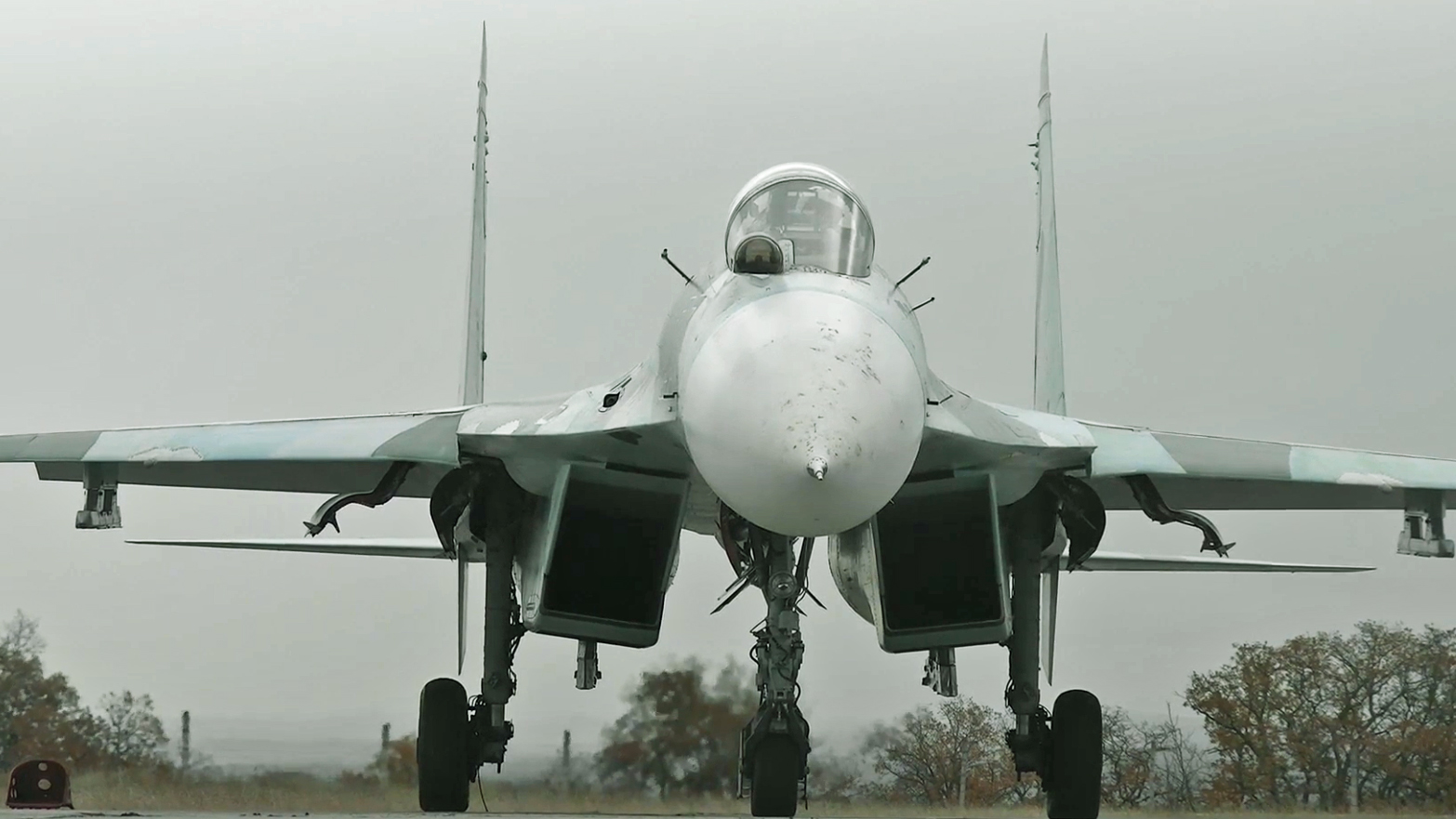An official Russian Ministry of Defense video provides our most in-depth look so far at one of the lesser-known combat aircraft involved in Moscow’s offensive in Ukraine. Operations by the Su-27 Flanker-B jets have been hardly documented until now, and not at all by official sources, in contrast to the more modern and more advanced Su-30SM and Su-35S versions of the Flanker. The latest video focuses on the Su-27SM, an upgraded version of the original ‘vanilla’ Flanker-B that is now, more generally, a diminishing presence within the Russian Aerospace Forces.
The brief clip, published on the Russian Ministry of Defense’s Zvezda TV channel, shows a Su-27SM conducting a combat air patrol, from takeoff through to landing, carrying an armament of two medium-range R-27 (AA-10 Alamo) and four short-range R-73 series (AA-11 Archer) air-to-air missiles.
The video shows a fairly worn-looking jet that’s assigned to the 38th Fighter Aviation Regiment (38 IAP, in Russian nomenclature), based at Belbek Airbase in the suburbs of Sevastopol, in Russian-occupied Crimea.

According to Zvezda TV, the Su-27SMs provide top cover for attack aircraft and bombers, as well as combat helicopters.
“On orders from the command post, we occupy the duty zone in the air,” said a Su-27 pilot, identified only as Alexander. “When a target is detected, we launch guided air-to-air missiles. We engage enemy unmanned aerial vehicles. We are on constant duty round the clock.”

The Su-27SM (as well as the non-upgraded Russian Su-27s, which have not so far been seen in the context of the war in Ukraine) are reportedly primarily tasked with the air defense of the Russian-occupied peninsula. This is especially important in light of the drone attacks that have been prosecuted against key military targets here.
So far, it seems Belbek has avoided any direct damage as a result of Ukrainian actions, at least that we know about. There were reports of explosions close to the base in August, although a pro-Moscow official said there was no damage to the facility itself.
“Air defense systems shot down … an unmanned aerial vehicle in the area of the Belbek airfield in Sevastopol, Governor Mikhail Razvozhaev said,” according to the Russian TASS news agency.
The resident 38 IAP at Belbek flies a mix of original, non-upgraded Su-27, two-seat Su-27UB Flanker-C combat trainers, and upgraded Su-27SMs, but is expected to eventually be re-equipped with single-seat Su-35S Flanker-Es. In the meantime, a handful of two-seat Su-30M2 aircraft are also being used for crew training in preparation for the more advanced Flanker.

While the Zvezda TV video seems to be the first official documentation of the Su-27SM being used in the war in Ukraine, one unofficial photo of one of the jets — carrying R-77-1 missiles among its armament — appeared in August, although it was initially misidentified as a Su-35S.
Away from Crimea, the same fighters likely also range out over the Black Sea to keep tabs on NATO surveillance aircraft and drones operating here. In September, a Su-27 — likely also from Belbek — “released” a missile during an encounter with a British Royal Air Force RC-135W Rivet Joint electronic surveillance aircraft, over the Black Sea. You can read about that incident here. While both British and Russian officials judged this to be accidental, it led to RAF RC-135s being escorted by Typhoon fighters while operating over these waters.
A Su-27 from Belbek was also very likely responsible for the so-called “unsafe intercept” between one of these aircraft and a U.S. Air Force B-52 bomber, deployed to RAF Fairford in the United Kingdom in the summer of 2020. That incident occurred on August 28 and involved a maneuver sometimes referred to as ‘thumping’ or a ‘headbutt,’ which has the potential to be extremely dangerous depending on how it is performed.

Su-27SM upgrades
The Su-27SM mid-life update program was launched in 2003, to extend the capabilities and lifespan of existing Su-27s, which had entered series production back in 1982. The Su-27SM was based around an updated fire-control system and made its first flight in prototype form in December 2002 at Komsomolsk-on-Amur, in the Russian Far East.
The first upgraded Su-27SMs began to return to service in late 2004 and they started to be deployed to Belbek Airbase in newly annexed Crimea in 2014.
As well as the upgraded Su-27SMs, a batch of 12 new-built aircraft was also completed to an improved standard in 2009. These are known as Su-27SM3 aircraft, sometimes also written Su-27SM(3), and feature a further enhanced fire-control system, and other modifications. Beginning in 2014, Su-27s also began to be returned to service having been upgraded to the same Su-27SM3 standard.
Outwardly, the Su-27SMs look very much the same as the old Su-27s, but a look into the cockpit (as in the Zvezda TV video) reveals that many of the old analog instruments and ‘steam gauges’ have given way to multi-functional displays. The two new 6×8-inch displays and the single data input panel between them have been obscured by the censor in the video.

Less obvious, of course, is the new fire-control system, derived from that used in the advanced Su-30MK2 jets that were built for China. This includes a modestly improved radar and electro-optical sighting system, including infrared search and track, allied with a more advanced mission computer. The result allows synthetic aperture terrain mapping and detection of maritime surface targets.

The new fire-control system also provides for a much-expanded choice of weapons. While the basic Su-27 was limited to R-27 and R-73 air-to-air missiles and unguided bombs and rockets, the Su-27SM can employ Kh-31A/P (AS-17 Krypton) anti-ship/anti-radiation missiles, Kh-29L/T/TD (AS-14 Kedge) laser-/TV-guided missiles, and laser-guided bombs.


Rarely, however, is the Su-27SM seen with air-to-ground ordnance, suggesting its primary role remains air defense. For this mission, the upgraded jet can carry the active radar-guided R-77-1 (AA-12 Adder) air-to-air missile, for a much-improved beyond-visual-range capability. Ukrainian Air Force pilots have spoken about the particular advantages that the R-77-1 provides the Russian fighters they encounter.
Other changes include an improved navigation system with a GPS receiver, as well as modifications to the self-protection suite. The Pastel radar warning receiver replaces the older Beryoza, while the wingtip Sorbtsiya jamming pods are superseded by the more modern Khibiny.
Twenty-four of the upgraded Su-27SMs also received slightly uprated engines, for a modest performance boost.

An airbase under occupation
Prior to the Russian annexation of Crimea, Belbek was home to Ukrainian Air Force MiG-29 Fulcrum fighter jets and also hosted other aircraft for live-fire exercises over the Black Sea.
Once Russian forces moved in, the 38 IAP was established here, and the old Soviet-era runway was replaced by a longer and more modern one.
When Moscow launched its full-scale invasion of Ukraine in February this year, Belbek received an influx of additional combat aircraft deployed from units in Russia. These have included examples of the Su-30SM and Su-35S, as well as Su-34 Fullback strike fighters, and MiG-31BM Foxhound interceptors. One of the MiG-31s was written off in an incident in October, when it departed the runway, crashed, and was completely burned out.
The exact complement of aircraft at Belbek has changed over time and, in the wake of the devastating explosions that knocked out multiple aircraft at Saki, another Crimean airbase, and an unconfirmed blast at Gvardeyskoe, reports began to circulate in August that Russia was moving aircraft out of Belbek, presumably for their own protection.
On August 11, the Ukrainian Ministry of Defense’s Main Directorate of Intelligence stated that five Su-27/30 fighters and five Su-34s relocated from Belbek to Gvardeyskoe. On August 17, meanwhile, the same source said that 14 aircraft of different types had been relocated from Belbek to various airbases in Krasnodar Krai, in Russia proper.
These reports were not fully verified and, while the air component at Belbek may have been subject to change, the base remains the main hub for Russian fighter jets operating against Ukraine.
As to why the Russian Ministry of Defense is only presenting imagery of the Su-27SM now, that needs to be seen in the context of the relatively poor performance by the Russian Aerospace Forces in the conflict so far, highlighted by their continuing inability to establish meaningful air superiority over Ukraine. This has, in turn, led to a spate of losses of mainly attack aircraft and helicopters to ground-based air defense systems. Media coverage of this kind is likely, above all, a means of shoring up public opinion at home, as the credibility of the country’s air defenses continues to be questioned.
With that last point in mind, it’s worth noting that the recent high-profile drone attacks on Russian airbases hundreds of miles from the Ukrainian front lines are now driving an increased focus on Russian air defense capabilities. This has brought attention all the more dramatically to the growing threat posed by Ukrainian drone strikes and the increasingly bold target list being devised by planners in Kyiv. While the Su-27s at Belbek may be among the oldest fighters of their kind still in operational use, they clearly still have an important role to play in the air defense realm.
Contact the author: thomas@thedrive.com
